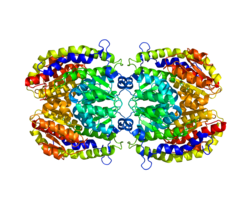GFPT1
Protein-coding gene in the species Homo sapiens
| GFPT1 | |||||||||||||||||||||||||||||||||||||||||||||||||||
|---|---|---|---|---|---|---|---|---|---|---|---|---|---|---|---|---|---|---|---|---|---|---|---|---|---|---|---|---|---|---|---|---|---|---|---|---|---|---|---|---|---|---|---|---|---|---|---|---|---|---|---|
 | |||||||||||||||||||||||||||||||||||||||||||||||||||
| |||||||||||||||||||||||||||||||||||||||||||||||||||
| Identifiers | |||||||||||||||||||||||||||||||||||||||||||||||||||
| Aliases | GFPT1, CMSTA1, GFA, GFAT, GFAT 1, GFAT1, GFAT1m, GFPT, GFPT1L, MSLG, CMS12, glutamine--fructose-6-phosphate transaminase 1 | ||||||||||||||||||||||||||||||||||||||||||||||||||
| External IDs | OMIM: 138292; MGI: 95698; HomoloGene: 68220; GeneCards: GFPT1; OMA:GFPT1 - orthologs | ||||||||||||||||||||||||||||||||||||||||||||||||||
| |||||||||||||||||||||||||||||||||||||||||||||||||||
| |||||||||||||||||||||||||||||||||||||||||||||||||||
| |||||||||||||||||||||||||||||||||||||||||||||||||||
| |||||||||||||||||||||||||||||||||||||||||||||||||||
| |||||||||||||||||||||||||||||||||||||||||||||||||||
| Wikidata | |||||||||||||||||||||||||||||||||||||||||||||||||||
| |||||||||||||||||||||||||||||||||||||||||||||||||||
Glucosamine—fructose-6-phosphate aminotransferase isomerizing 1 is an enzyme that in humans is encoded by the GFPT1 gene.[5][6]
Glutamine-fructose-6-phosphate transaminase 1 is the first and rate-limiting enzyme of the hexosamine pathway. GFAT controls the flux of glucose into the hexosamine pathway and catalyzes the formation of glucosamine 6-phosphate.[6]
References
- ^ a b c GRCh38: Ensembl release 89: ENSG00000198380 – Ensembl, May 2017
- ^ a b c GRCm38: Ensembl release 89: ENSMUSG00000029992 – Ensembl, May 2017
- ^ "Human PubMed Reference:". National Center for Biotechnology Information, U.S. National Library of Medicine.
- ^ "Mouse PubMed Reference:". National Center for Biotechnology Information, U.S. National Library of Medicine.
- ^ McKnight GL, Mudri SL, Mathewes SL, Traxinger RR, Marshall S, Sheppard PO, O'Hara PJ (Jan 1993). "Molecular cloning, cDNA sequence, and bacterial expression of human glutamine:fructose-6-phosphate amidotransferase". J Biol Chem. 267 (35): 25208–12. doi:10.1016/S0021-9258(19)74026-5. PMID 1460020.
- ^ a b "Entrez Gene: GFPT1 glutamine-fructose-6-phosphate transaminase 1".
Further reading
- Schleicher ED, Weigert C (2001). "Role of the hexosamine biosynthetic pathway in diabetic nephropathy". Kidney Int. Suppl. 77: S13–8. doi:10.1046/j.1523-1755.2000.07703.x. PMID 10997685.
- Traxinger RR, Marshall S (1991). "Coordinated regulation of glutamine:fructose-6-phosphate amidotransferase activity by insulin, glucose, and glutamine. Role of hexosamine biosynthesis in enzyme regulation". J. Biol. Chem. 266 (16): 10148–54. doi:10.1016/S0021-9258(18)99202-1. PMID 2037571.
- Whitmore TE, Mudri SL, McKnight GL (1995). "Physical mapping of the human glutamine:fructose-6-phosphate amidotransferase gene (GFPT) to chromosome 2p13". Genomics. 26 (2): 422–3. doi:10.1016/0888-7543(95)80235-E. PMID 7601477.
- Zhou J, Neidigh JL, Espinosa R, et al. (1995). "Human glutamine: fructose-6-phosphate amidotransferase: characterization of mRNA and chromosomal assignment to 2p13". Hum. Genet. 96 (1): 99–101. doi:10.1007/BF00214194. PMID 7607664. S2CID 25484995.
- Sayeski PP, Paterson AJ, Kudlow JE (1994). "The murine glutamine:fructose-6-phosphate amidotransferase-encoding cDNA sequence". Gene. 140 (2): 289–90. doi:10.1016/0378-1119(94)90560-6. PMID 8144040.
- Nerlich AG, Sauer U, Kolm-Litty V, et al. (1998). "Expression of glutamine:fructose-6-phosphate amidotransferase in human tissues: evidence for high variability and distinct regulation in diabetes". Diabetes. 47 (2): 170–8. doi:10.2337/diabetes.47.2.170. PMID 9519709.
- Oki T, Yamazaki K, Kuromitsu J, et al. (1999). "cDNA cloning and mapping of a novel subtype of glutamine:fructose-6-phosphate amidotransferase (GFAT2) in human and mouse". Genomics. 57 (2): 227–34. doi:10.1006/geno.1999.5785. PMID 10198162.
- Chang Q, Su K, Baker JR, et al. (2000). "Phosphorylation of human glutamine:fructose-6-phosphate amidotransferase by cAMP-dependent protein kinase at serine 205 blocks the enzyme activity". J. Biol. Chem. 275 (29): 21981–7. doi:10.1074/jbc.M001049200. PMID 10806197.
- Niimi M, Ogawara T, Yamashita T, et al. (2001). "Identification of GFAT1-L, a novel splice variant of human glutamine: fructose-6-phosphate amidotransferase (GFAT1) that is expressed abundantly in skeletal muscle". J. Hum. Genet. 46 (10): 566–71. doi:10.1007/s100380170022. PMID 11587069.
- DeHaven JE, Robinson KA, Nelson BA, Buse MG (2001). "A novel variant of glutamine: fructose-6-phosphate amidotransferase-1 (GFAT1) mRNA is selectively expressed in striated muscle". Diabetes. 50 (11): 2419–24. doi:10.2337/diabetes.50.11.2419. PMID 11679416.
- Strausberg RL, Feingold EA, Grouse LH, et al. (2003). "Generation and initial analysis of more than 15,000 full-length human and mouse cDNA sequences". Proc. Natl. Acad. Sci. U.S.A. 99 (26): 16899–903. Bibcode:2002PNAS...9916899M. doi:10.1073/pnas.242603899. PMC 139241. PMID 12477932.
- Weigert C, Friess U, Brodbeck K, et al. (2004). "Glutamine:fructose-6-phosphate aminotransferase enzyme activity is necessary for the induction of TGF-beta1 and fibronectin expression in mesangial cells". Diabetologia. 46 (6): 852–5. doi:10.1007/s00125-003-1122-8. PMID 12802498.
- Ng DP, Walker WH, Chia KS, et al. (2004). "Scrutiny of the glutamine-fructose-6-phosphate transaminase 1 (GFPT1) locus reveals conserved haplotype block structure not associated with diabetic nephropathy". Diabetes. 53 (3): 865–9. doi:10.2337/diabetes.53.3.865. PMID 14988277.
- Elbein SC, Zheng H, Jia Y, et al. (2005). "Molecular screening of the human glutamine-fructose-6-phosphate amidotransferase 1 (GFPT1) gene and association studies with diabetes and diabetic nephropathy". Mol. Genet. Metab. 82 (4): 321–8. doi:10.1016/j.ymgme.2004.05.004. PMID 15308130.
- Gerhard DS, Wagner L, Feingold EA, et al. (2004). "The status, quality, and expansion of the NIH full-length cDNA project: the Mammalian Gene Collection (MGC)". Genome Res. 14 (10B): 2121–7. doi:10.1101/gr.2596504. PMC 528928. PMID 15489334.
- Chou KC (2005). "Molecular therapeutic target for type-2 diabetes". J. Proteome Res. 3 (6): 1284–8. doi:10.1021/pr049849v. PMID 15595739.
- Weigert C, Thamer C, Brodbeck K, et al. (2005). "The -913 G/A glutamine:fructose-6-phosphate aminotransferase gene polymorphism is associated with measures of obesity and intramyocellular lipid content in nondiabetic subjects". J. Clin. Endocrinol. Metab. 90 (3): 1639–43. doi:10.1210/jc.2004-0058. PMID 15613432.
- Burt D, Brodbeck K, Häring HU, et al. (2005). "Partial characterisation of the human GFAT promoter: effect of single nucleotide polymorphisms on promoter function". Biochim. Biophys. Acta. 1740 (1): 85–90. doi:10.1016/j.bbadis.2005.01.007. PMID 15878746.
- v
- t
- e


















